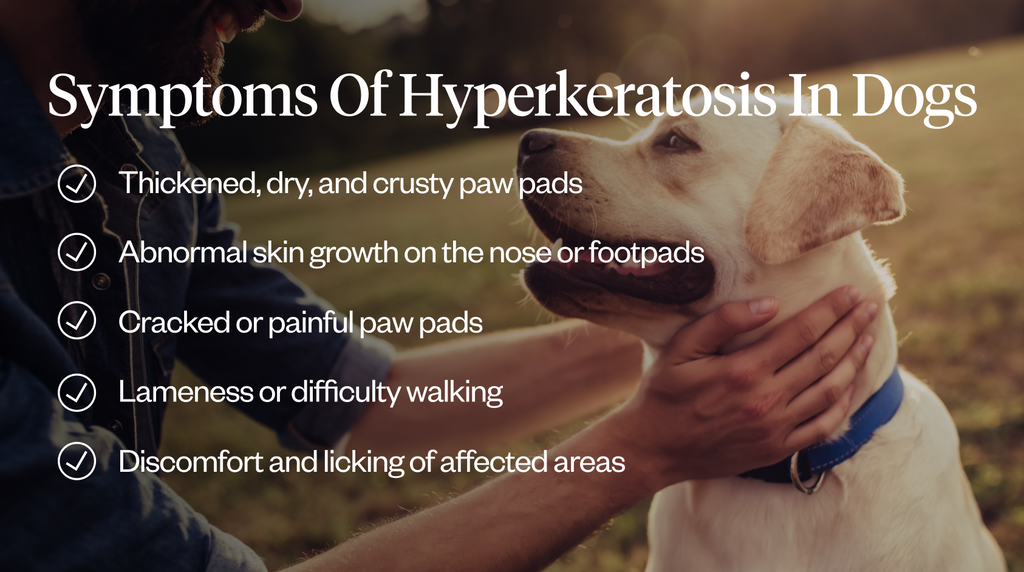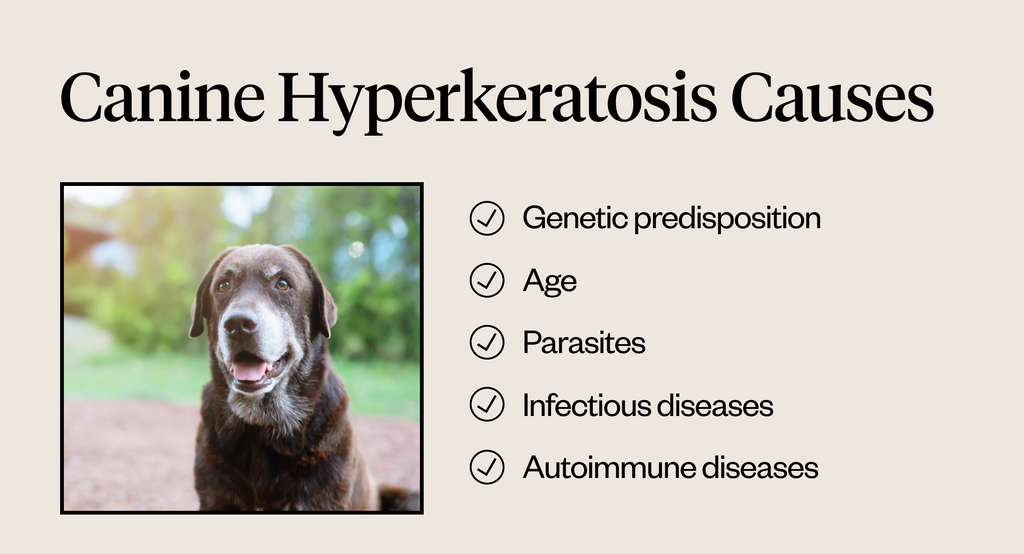11 Min Read
Hyperkeratosis In Dogs: Everything You Need To Know
Key takeaway
Hyperkeratosis in dogs is a skin condition where dogs produce too much keratin, which causes changes in the texture and appearance of the skin. Hyperkeratosis isn’t a medical emergency, but it may require treatment in severe cases. You can prevent hyperkeratosis by having your dog vaccinated and groomed and maintaining a clean environment.

Why pet owners are switching to online vet care with Dutch
-
Prescriptions delivered free to you
-
Fast access to Licensed Vets over video
-
Unlimited video visits and follow-ups
From vet visits to learning which symptoms to watch for, keeping your pup healthy can feel like a full-time job. Skin conditions are a big concern with dogs — especially if your dog has allergies. Sometimes, skin abnormalities are caused by something more than a simple rash or allergy.
Hyperkeratosis in dogs isn’t extremely common, but it occurs more than you might expect. There are several potential causes, and certain breeds are at higher risk than others. Understanding the symptoms and how to treat hyperkeratosis in dogs can help you keep your pets healthy.
Have you seen your dog chewing their paws? Have you noticed changes in the texture of their skin? Here’s what you need to know about hyperkeratosis in dogs.
- What Is Hyperkeratosis In Dogs?
- Symptoms Of Hyperkeratosis In Dogs
- What Causes Hyperkeratosis In Dogs?
- Diagnosing Canine Hyperkeratosis
- Treating Canine Hyperkeratosis
- Preventing Hyperkeratosis In Dogs
- Hyperkeratosis In Dogs: FAQs
- Final Notes
What Is Hyperkeratosis In Dogs?
Hyperkeratosis in dogs is a skin condition that occurs as a result of excess keratin production. In healthy dogs, keratin plays an essential role in the development of fur, skin, and nails. Keratin is actually the primary protein in the skin, nails, and hair, playing a key role in hair and nail growth, wound healing, and more. A healthy amount of keratin protects the skin, but excess production can result in skin changes that can make life difficult for your dog.[1]
When too much keratin is produced, it can cause the skin to become harder and thicker. These changes often occur on the paws and nose, but they can affect several regions. As the skin continues to harden and become thicker, you may spot cracked dog paws and other symptoms as a result.[1]
Symptoms Of Hyperkeratosis In Dogs

As a pet parent, it’s important to know when something isn’t right with your dog. Knowing the symptoms of hyperkeratosis can help you get your dog to the vet sooner, so they can start treatment for hyperkeratosis in dogs.
Hyperkeratosis causes keratin to accumulate — often on the nose or foot pads. When the nose is affected, it’s known as nasal hyperkeratosis in dogs. As keratin builds up and hardens on the foot pads, it can lead to pain and discomfort. Severe cases of hyperkeratosis may cause bleeding paws, but that bleeding could also be caused by a cut or other damage to the paw. Keratin typically accumulates on the edges of the pads.[3]
Cracks in the paws can lead to open wounds, which can put your dog at higher risk for infection. When the outer protective layer cracks, the skin it’s protecting is susceptible to bacteria. Infections can lead to serious medical issues — especially if you don’t treat them fast — so treating hyperkeratosis is crucial.[3]
There are several other symptoms you may notice if your dog has hyperkeratosis. Hyperkeratosis can cause your dog to lick their paws frequently because of the discomfort and sensitivity. If your dog is in pain, they may spend more time lying around the house. Sudden inactivity is one of the easiest ways to tell if there’s something going on with your dog.[3]
What Causes Hyperkeratosis In Dogs?

Determining the cause of hyperkeratosis in dogs can help you choose the best treatment plan. Hyperkeratosis has many potential causes, and your vet can help you learn more about what causes hyperkeratosis.
Age plays a role in the development of hyperkeratosis in dogs. Many cases of hyperkeratosis are seen in older dogs, which may be a result of the skin thickening as your dog gets older.[1]
Parasites can also lead to hyperkeratosis in some cases. Certain types of parasites can trigger increased keratin production in dogs, which can lead to hyperkeratosis. These parasites include leishmaniasis, which comes from sandfly bites.[1]
Certain infectious diseases — including canine distemper virus and papillomavirus can cause hyperkeratosis in dogs. Getting your dog vaccinated is a critical part of preventing hyperkeratosis and other medical conditions.[1] You should also keep an eye out for symptoms of infectious diseases, that way you can get the proper prescription from an online pharmacy.
Autoimmune disorders can change the way your dog’s body works in several ways, and that includes increasing keratin production.[1]
In some cases, hyperkeratosis is a result of genetics. Certain breeds are at higher risk of developing hyperkeratosis, including Irish Terriers and Dogues de Bordeaux.[2] If you have a dog whose breed is susceptible to hyperkeratosis, recognizing the symptoms is especially important. As soon as you notice something amiss with your dog, you can take them to the vet to prevent further complications.
Diagnosing Canine Hyperkeratosis
Canine hyperkeratosis can lead to symptoms that look like dog paw burns and other skin conditions, which is why it’s so important to get a proper diagnosis. Your vet can accurately diagnose your dog and help you formulate a plan to treat hyperkeratosis.
Diagnosing hyperkeratosis in dogs can be a pretty straightforward process for vets. In older dogs who are otherwise healthy, a clinical examination is usually enough to diagnose hyperkeratosis. Histopathological examination may be required in some cases, which is when tissue is examined under a microscope. In many cases, histopathological examination isn’t required.[3]
Hyperkeratosis can be harder to diagnose in younger dogs because there are several potential causes of these symptoms. If your dog is young, your vet will typically start with a physical examination to check for signs of hyperkeratosis. After confirming hyperkeratosis symptoms, your vet may use different tests to rule out other potential medical conditions. Some of the other medical conditions your dog might have include:
- Canine distemper
- Pemphigus foliaceus
- Leishmaniasis
- Zinc responsive dermatosis
- Superficial necrolytic dermatitis
- Nasal parakeratosis[3]
These conditions are generally rarer than hyperkeratosis, but it’s important to have your vet rule out other potential diseases so you’re getting your dog the proper treatment.
Treating Canine Hyperkeratosis
Treatment for hyperkeratosis in dogs can help restore healthy skin and prevent complications such as infection. Remember, always talk to your vet before you make any decisions regarding the treatment of hyperkeratosis in dogs.
To begin with, your vet may remove some of the excess keratin from your dog’s paws or nose. Once this keratin has been removed, the skin can be rehydrated with a combination of warm water and petroleum jelly — this process takes about 10 days.[3] Dog boots or bandages can help you keep your dog from making a mess around your house.
Once that 10-day period has passed, your vet may want to remove additional keratin from your dog’s paws. This second removal helps restore the natural shape of your dog’s paws, which can ease discomfort. Removing this second layer of keratin is a delicate balance — if you go too far, you can damage the skin.[3]
If fissuring or ulceration results from hyperkeratosis, that area should be treated with a steroid/antibiotic cream to reduce the risk of infection. If you notice any signs of an infection, take your dog to the vet right away.[3]
Applying petroleum jelly and trimming the area weekly can help prevent complications caused by hyperkeratosis as well.[3] When you trim your dog’s nails, you can take care of their paws and pads as well.
Preventing Hyperkeratosis In Dogs

Like many medical conditions, hyperkeratosis in dogs isn’t something you can simply prevent. Instead, the focus is on reducing the risk of hyperkeratosis and recognizing symptoms so you can start treatment as soon as possible.
Start by making sure your dog is eating a healthy diet that supports skin health. Diet plays an essential role in skin health, keeping your dog’s skin and coat moisturized and healthy. A good diet includes fatty acids, vitamins, and minerals.
Make sure your dog also has access to fresh water at all times. Dogs need hydration just like humans do, so it’s your job as a pet parent to make sure your dog always has water in their bowl.
You can protect your dog’s paws by keeping them away from potential irritants. Certain chemicals can cause skin irritation in dogs, but sidewalks and roads are a huge issue that people don’t often consider. Avoid walking your dog on hot pavement or roads that have been covered with road salt. These surfaces can damage your dog’s paws, which can lead to infections and other complications.
When you’re grooming your dog, take an extra moment to trim the excess hair between the paw pads and the nails to prevent it from building up. This only takes a few minutes, and it can help prevent hyperkeratosis in dogs.
Hyperkeratosis In Dogs: FAQs
How serious is hyperkeratosis in dogs?
Hyperkeratosis in dogs isn’t usually considered a medical emergency or life-threatening condition, but it all depends on the treatment and severity of symptoms. Severe cases of hyperkeratosis can lead to pain, discomfort, and complications such as infection, so it’s important to get a diagnosis as early as possible. Starting treatment right away helps prevent severe hyperkeratosis while providing relief from symptoms. Hyperkeratosis in dogs can range from a minor cosmetic issue to a painful condition that leads to complications — it’s all about how you treat it.
Is hyperkeratosis painful for dogs?
For the most part, hyperkeratosis isn’t an especially painful skin condition for dogs. In the early stages, hyperkeratosis may lead to discomfort due to the hardened skin. If you let hyperkeratosis develop and become more severe, it can become painful. The best thing you can do to prevent pain caused by hyperkeratosis in dogs is to take your dog to the vet for regular checkups. Even if you don’t think there’s anything wrong, routine checkups can help you keep your dog healthy.

Final Notes
Being a pet parent is hard work, especially if your dog is prone to certain medical conditions. Fortunately, you can get help instead of dealing with these medical issues on your own.
Dutch allows you to connect with vets online, so you can get the help you need from the comfort of your home. Through an online video appointment, our vets can offer tips and help you diagnose hyperkeratosis in dogs. We can deliver your pup’s prescriptions to your doorstep. Try Dutch today to find out how we make life easier for pet parents.
Share
References
-
"Hyperkeratosis in Dogs: An Overview." TPLO Info. Aug 2021. https://tploinfo.com/blog/hyperkeratosis-in-dogs-an-overview/.
-
Moriello, Karen A. "Congenital and Inherited Skin Disorders in Dogs." Merck Veterinary Manual. Oct 2022.https://www.merckvetmanual.com/dog-owners/skin-disorders-of-dogs/congenital-and-inherited-skin-disorders-in-dogs.
-
Grant, David. "Idiopathic nasodigital hyperkeratosis." Improve Veterinary Practice. https://www.veterinary-practice.com/article/idiopathic-nasodigital-hyperkeratosis.




